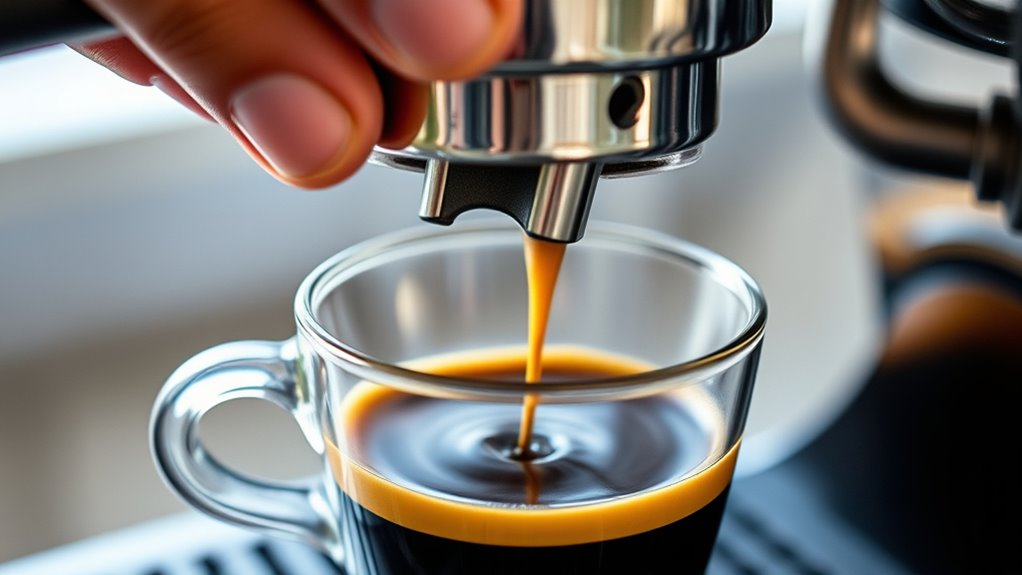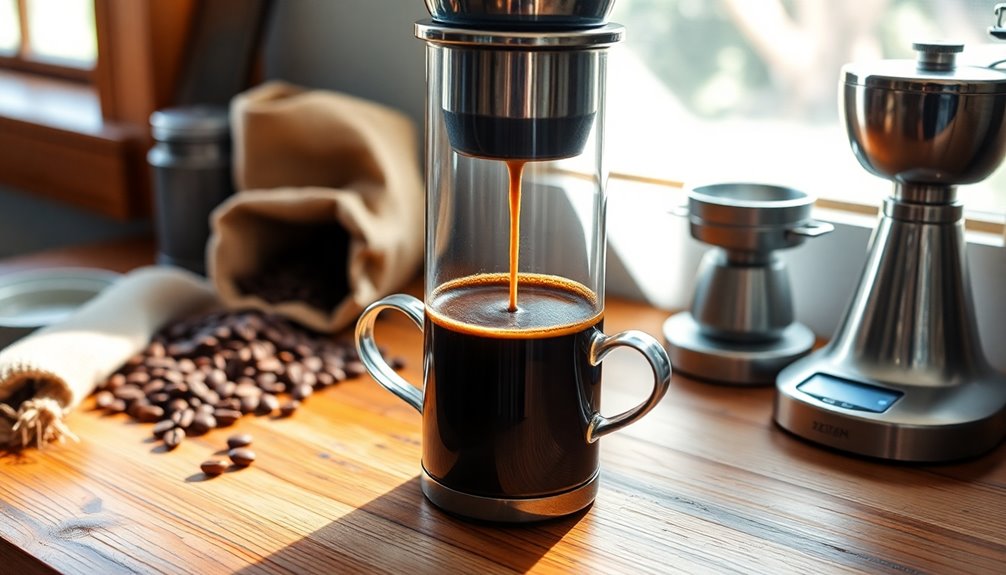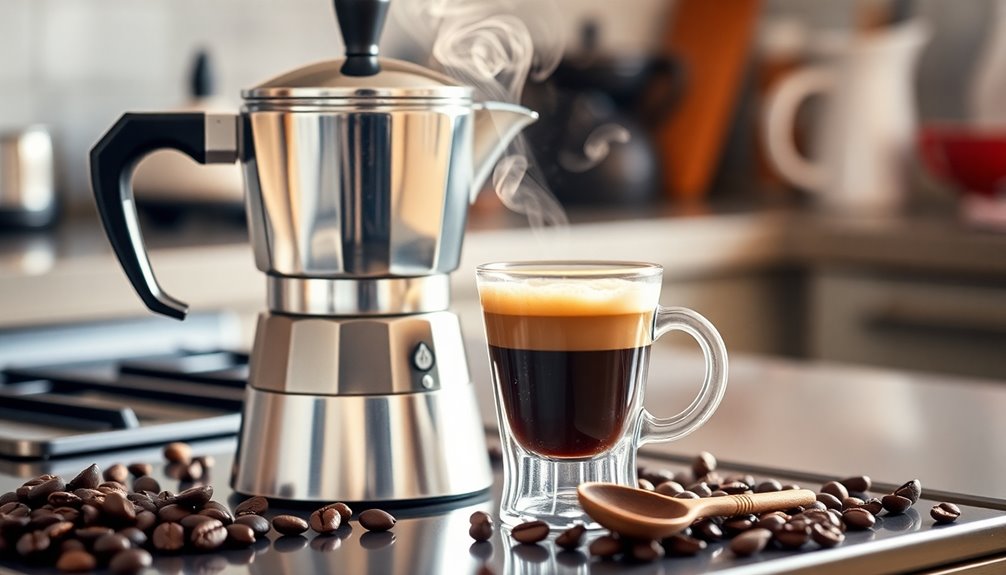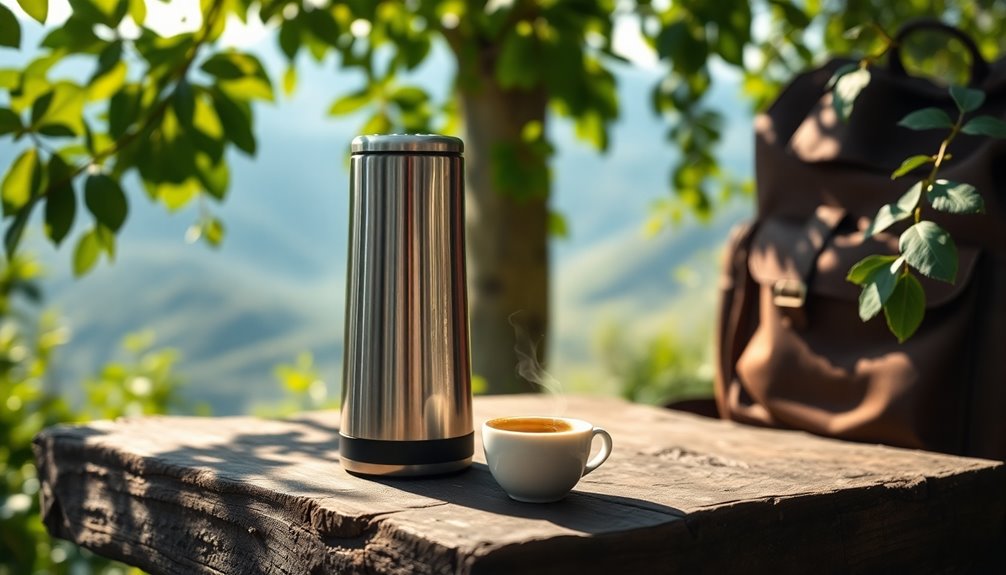Mastering espresso extraction time is key to making great shots. From start to finish, it’s the countdown of how long hot water passes through your grounds—aiming for about 25-30 seconds. Factors like grind size, tamping pressure, and machine settings influence this timing. Too short or long affects flavor, so adjusting these variables helps you get a balanced, flavorful espresso. Keep exploring to open even better brew control and consistency.
Key Takeaways
- Extraction time measures how long hot water passes through coffee grounds, impacting flavor balance and shot quality.
- Ideal extraction time ranges between 25-30 seconds; adjustments in grind size and tamp pressure help achieve it.
- Use a stopwatch from flow start to stop for precise measurement; visual cues like crema color can also guide timing.
- Factors like grind size, pressure, temperature, and equipment maintenance influence extraction duration and consistency.
- Regularly monitoring and adjusting extraction time ensures balanced, flavorful espresso shots and improves brewing skills.
What Is Espresso Extraction Time?

Have you ever wondered how long it takes to extract the perfect shot of espresso? Extraction time refers to the duration it takes for hot water to pass through your coffee grounds and produce that rich, flavorful shot. It begins once you start the pump and ends when the flow stops. The coffee grind size plays a vital role—too fine, and water struggles to flow, leading to over-extraction; too coarse, and water rushes through, under-extracting. Tamping pressure is equally important; applying consistent, firm pressure ensures even extraction. Proper tamping creates resistance that allows water to extract flavors evenly. Monitoring extraction time helps you control the process, ensuring your espresso isn’t under- or over-extracted. Adjusting factors like grind size and tamping can help optimize extraction, making Extraction time a crucial element in achieving perfect espresso. Getting these details right results in a balanced, delicious shot every time.
Why Does Extraction Time Matter?
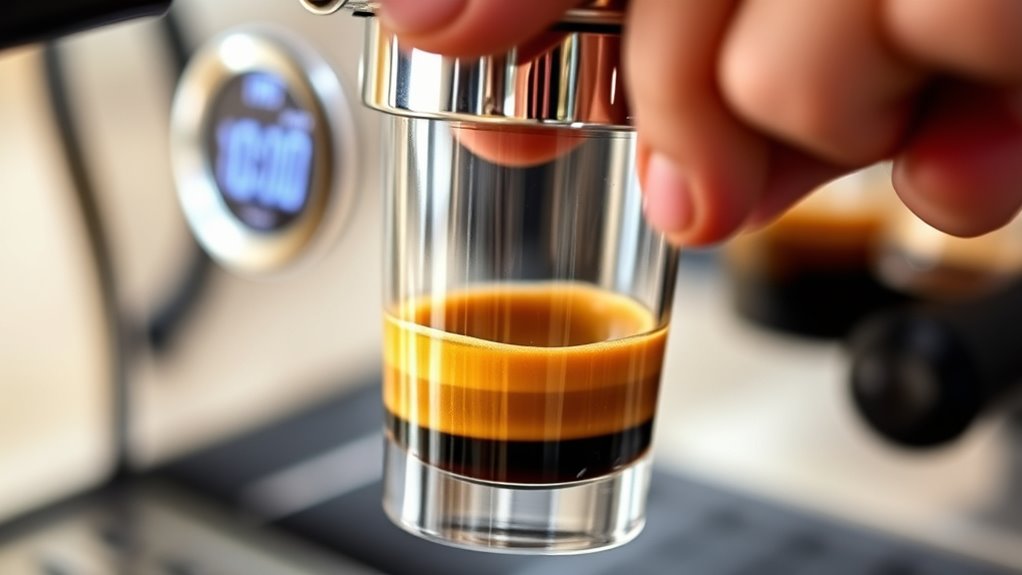
Extraction time affects the flavor balance of your espresso, helping you achieve the taste you prefer. It also guarantees your brews stay consistent from shot to shot. Paying attention to extraction time lets you fine-tune your process for better results.
Flavor Balance Control
Why does timing matter when brewing espresso? Extraction time directly influences flavor balance. If your grind is too fresh or your tamping pressure is uneven, it can cause inconsistent extraction, skewing the flavor. Freshly ground beans release more gases, which can lead to over-extraction if not managed properly, making the shot bitter. Conversely, too much tamping pressure may restrict water flow, resulting in under-extraction and sour flavors. Adjusting extraction time helps you fine-tune this balance—shorter times may highlight brighter, acidic notes, while longer ones deepen the body and sweetness. Understanding how grain freshness and tamping pressure impact extraction allows you to control flavor nuances, ensuring your espresso hits that perfect harmony of acidity, sweetness, and bitterness. Additionally, Extraction time plays a vital role in optimizing the overall quality of your espresso shot.
Consistency in Brew
Maintaining consistency in your espresso brew hinges on controlling extraction time, which directly impacts the final flavor profile. Small adjustments in grind size and tamp pressure can make a big difference. When your grind is too fine or tamp pressure too firm, extraction takes longer, risking over-extraction and bitterness. Conversely, a coarse grind or light tamp can lead to under-extraction and sourness. To keep your shots consistent, focus on:
- Adjusting grind size precisely for each batch
- Applying even tamp pressure every time
- Monitoring extraction time closely
- Making incremental tweaks to maintain balance
- Understanding industry trends helps in refining your technique aiding in your progress.
How to Measure Your Extraction Time

To accurately measure your espresso extraction time, you need to start the stopwatch as soon as the coffee begins to flow from the portafilter. Watch closely for the stream to emerge and hit the 25-30 second mark. Your grind size and tamp pressure directly influence this timing; a finer grind or firmer tamp typically slows extraction, while a coarser grind or lighter tamp speeds it up. Adjust these variables to achieve your desired flow rate, then measure again. Use your stopwatch consistently to track how long your shot takes. Keep in mind that small changes in grind size or tamp pressure can profoundly affect extraction time. Regular measurement helps you develop a better understanding of how your adjustments impact the shot.
Ideal Extraction Time for a Perfect Shot

The ideal extraction time for a perfect shot typically falls within the range of 25 to 30 seconds. Achieving this depends on proper grind size and tamp pressure. If your grind is too fine, extraction takes longer; too coarse, it’s faster. Consistent tamp pressure ensures even extraction and prevents channeling. To dial in your shot, consider these tips:
- Adjust your grind size for a balanced flow
- Use firm, even tamp pressure for uniform extraction
- Monitor shot duration closely within the 25-30 second window
- Aim for a rich, caramel-colored crema as a sign of proper extraction
- Regularly calibrating your equipment and understanding the financial aspects involved can help maintain consistency and quality in your brewing process.
Mastering these elements helps you hit that sweet spot and pull consistently excellent espresso shots.
Factors That Influence Extraction Time
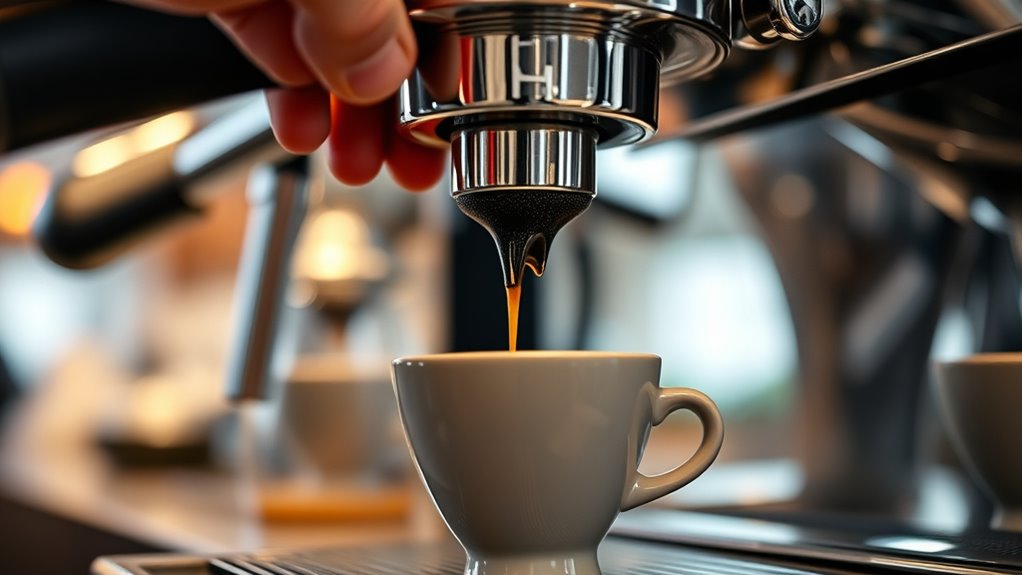
Several key factors directly impact how long your espresso extraction takes. Two of the most important are grind size and tamp pressure. If your grind is too coarse, water flows quickly through the coffee, resulting in a shorter extraction time and potentially weak flavor. Conversely, a fine grind slows water flow, increasing extraction time and extracting more flavors. Tamp pressure also plays a vital role; applying too much pressure can compact the coffee too tightly, prolonging extraction, while too little pressure allows water to pass too easily, shortening the process. Achieving the right balance between grind size and tamp pressure helps you control your extraction time, ensuring a shot that’s neither under-extracted nor over-extracted. Paying attention to these factors is essential for consistent, quality espresso. Additionally, understanding the trustworthiness of your brewing process and monitoring variables can help improve your results over time.
Tips for Adjusting Your Extraction Time
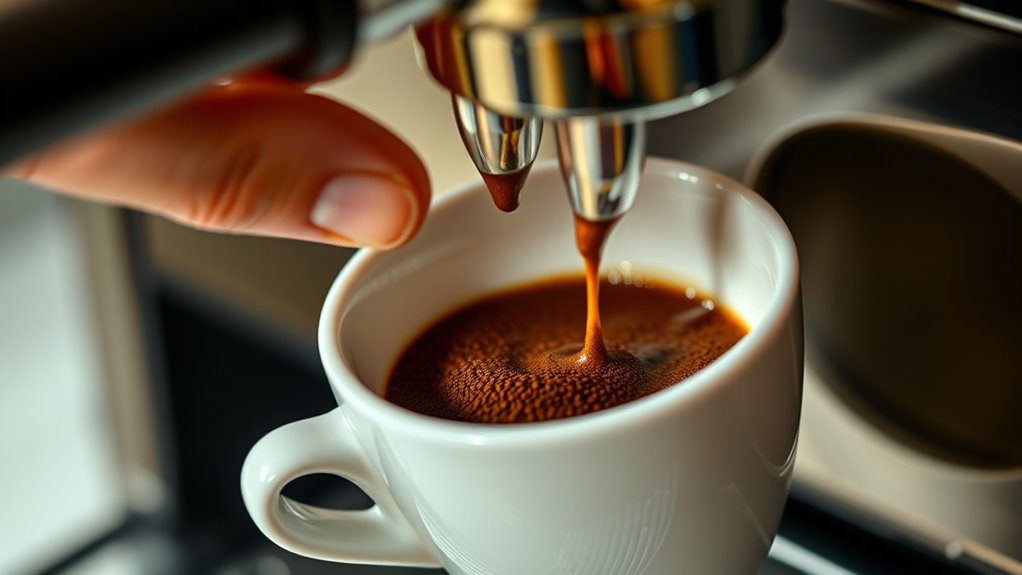
Adjusting your extraction time involves making precise tweaks to your grind size and tamp pressure based on the shot’s current performance. If your shot’s too fast, try fine-tuning your grind size to be slightly finer, or increase tamp pressure to slow extraction. Conversely, if it’s too slow, coarsen the grind or reduce tamp pressure. Small adjustments make a big difference in achieving the ideal extraction time.
Adjust grind size and tamp pressure gradually to perfect your espresso extraction time.
Here are some tips to help you fine-tune your process:
- Gradually adjust grind size in tiny increments
- Consistently apply even tamp pressure
- Record changes to find the best combination
- Test each adjustment with a single shot before proceeding
Mastering these tweaks ensures a balanced, flavorful espresso every time.
Troubleshooting Common Extraction Issues
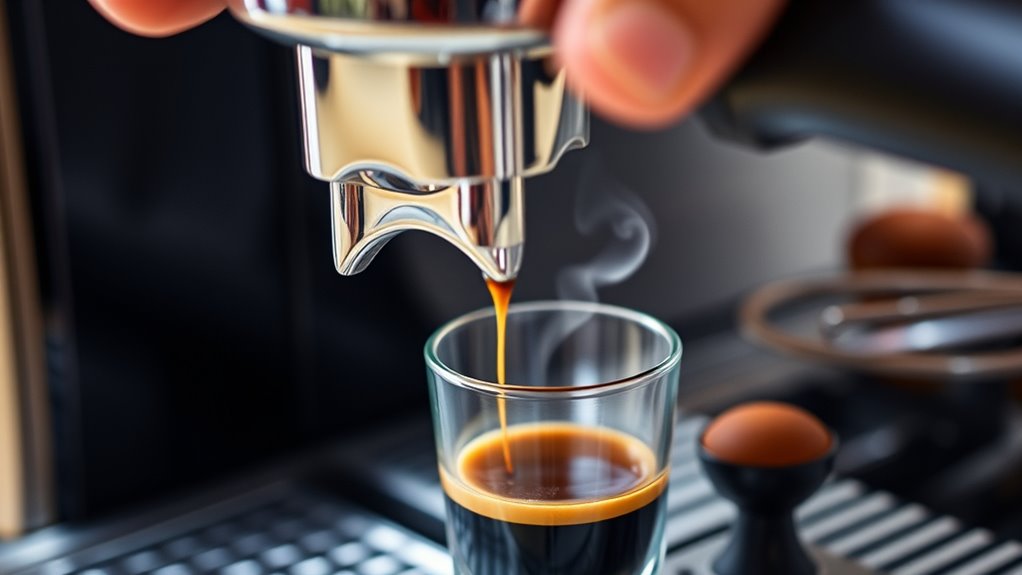
When your espresso extraction doesn’t go as planned, pinpointing the issue quickly can save time and improve your results. Start by evaluating your grind size; if the shot is too bitter or slow, try a coarser grind. If it’s too sour or quick, go finer. Next, check your tamp pressure—if you’re tamping unevenly or too lightly, water may flow too quickly, leading to under-extraction. Conversely, excessive tamp pressure can cause over-extraction and bitterness. Adjust these variables incrementally and observe changes in your shot. Consistency is key: use a consistent grind size and tamp pressure for predictable results. Troubleshooting often involves small tweaks, so stay patient and methodical to refine your extraction process effectively. Regularly maintaining your equipment and understanding the extraction time can also help you identify issues more precisely.
Frequently Asked Questions
Can Extraction Time Affect the Flavor Profile of My Espresso?
Yes, extraction time substantially impacts your espresso’s flavor profile. If you pull your shot too short or too long, it can mask delicate flavor nuances or introduce bitterness. By maintaining consistent extraction time, you enhance brewing consistency, allowing the true flavors of your beans to shine. Adjusting this timing helps you fine-tune the balance, ensuring each shot delivers the rich, nuanced taste you’re aiming for.
What Equipment Is Best for Precise Extraction Timing?
Did you know that baristas often aim for extraction times between 25-30 seconds for ideal flavor? To achieve precise timing, invest in high-quality coffee accessories like a calibrated scale, a timer, and a consistent tamper. When practicing brewing techniques, a good espresso machine with adjustable grind settings and a reliable shot timer helps you control extraction time accurately, ensuring a richer, more balanced espresso every time.
How Does Grind Size Influence Extraction Time?
Your grind size directly affects extraction time because a finer grind increases resistance, leading to slower flow, while a coarser grind speeds it up. Maintaining grind consistency and dose precision is essential to achieve the desired extraction time. If your grind is too fine or inconsistent, it can result in over-extraction or under-extraction, affecting flavor. Adjust your grind size gradually, ensuring uniformity for ideal espresso extraction.
Is Longer Extraction Always Better for Espresso Quality?
Longer extraction isn’t always better; it’s like overcooking a perfect steak until it’s dry and flavorless. You need the right balance of brew temperature and tamping pressure to optimize flavor. If extraction goes too long, the espresso turns bitter and over-extracted, ruining your shot. Instead, aim for a precise extraction time, adjusting parameters to highlight the espresso’s rich, balanced notes—longer isn’t automatically better.
How Do I Record and Track My Extraction Times Accurately?
You can record and track your extraction times accurately by using a digital timer for precise measurements. Start timing as soon as you begin the shot and stop once it reaches your desired volume or taste. Keep detailed tasting notes alongside the timing to identify which extraction times produce the best flavor. Consistently log your results to refine your technique and improve your espresso quality over time.
Conclusion
Remember, mastering espresso extraction is like tuning a delicate instrument—you’ll hit the right notes by paying attention to time. With patience and a keen eye, you’ll craft shots that dance on your palate, turning everyday mornings into a symphony of flavor. Keep experimenting, stay curious, and let your espresso journey unfold like a beautiful sunrise—bright, bold, and perfectly timed. Cheers to brewing brilliance in every cup!
